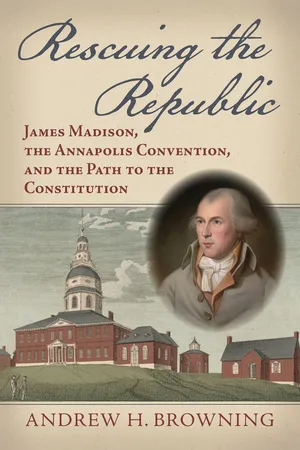
Rescuing the Republic
James Madison, the Annapolis Convention, and the Path to the Constitution
- English
- ePUB (mobile friendly)
- Available on iOS & Android
Rescuing the Republic
James Madison, the Annapolis Convention, and the Path to the Constitution
About this book
The first examination of how James Madison and the Annapolis Convention defied all odds and expectations to begin the near-impossible process of restructuring the federal government and worked to bring the republic back from the brink of collapse.
Although many books address the who, what, and why of the Constitution’s framing, not one explains the how of calling the Constitutional Convention—how a convention that seemed patently forbidden by the Articles of Confederation, and appeared so impossible to Alexander Hamilton that he quit Congress in despair of ever seeing one called, could have gathered enough support over a few months to be attended by every state but one.
Resolving that conundrum is the aim of Rescuing the Republic. Andrew Browning sets the stage with an explanation of the fatal flaws in the Articles of Confederation that were becoming apparent in the early years of American independence. He then explains how Madison—with the support of Washington and late assistance from Hamilton—built on the surprising success of the Mount Vernon Conference to arrange the widely misunderstood Annapolis Convention. Just as the decade-old Union was threatening to dissolve, that convention’s “stealth” success enabled Madison to overcome the previously insurmountable obstacles to restructuring the federal government. Far from being the “fiasco” it has been called, the Annapolis Convention is shown to have been the essential springboard to the Constitutional Convention. Circumventing populist demagogues and extreme advocates of states’ rights, it made possible what Madison called the “rescue of the Union, and the blessings of liberty staked on it, from an impending catastrophe.”
At a time when Americans are once again strongly divided over their vision of the country, Browning’s lucid study is a reminder of the deep roots of resistance to a truly national government—and of the risks inherent in returning to a confederation of quasi-sovereign states.
Frequently asked questions
- Essential is ideal for learners and professionals who enjoy exploring a wide range of subjects. Access the Essential Library with 800,000+ trusted titles and best-sellers across business, personal growth, and the humanities. Includes unlimited reading time and Standard Read Aloud voice.
- Complete: Perfect for advanced learners and researchers needing full, unrestricted access. Unlock 1.4M+ books across hundreds of subjects, including academic and specialized titles. The Complete Plan also includes advanced features like Premium Read Aloud and Research Assistant.
Please note we cannot support devices running on iOS 13 and Android 7 or earlier. Learn more about using the app.
Information
Table of contents
- Front Cover
- Half Title
- Title Page
- Copyright Page
- Dedication
- Table of Contents
- Acknowledgments
- Introduction
- 1 “A Rope of Sand”: 1775–1783
- 2 “Imbecility”: 1783–1786
- 3 “Calling a Convention of the States”: 1784–1786
- 4 “Having Rather Exceeded Our Authority”: 1786–1787
- Epilogue: “A More Perfect Union”
- Notes
- A Note on Sources
- Index
- Back Cover